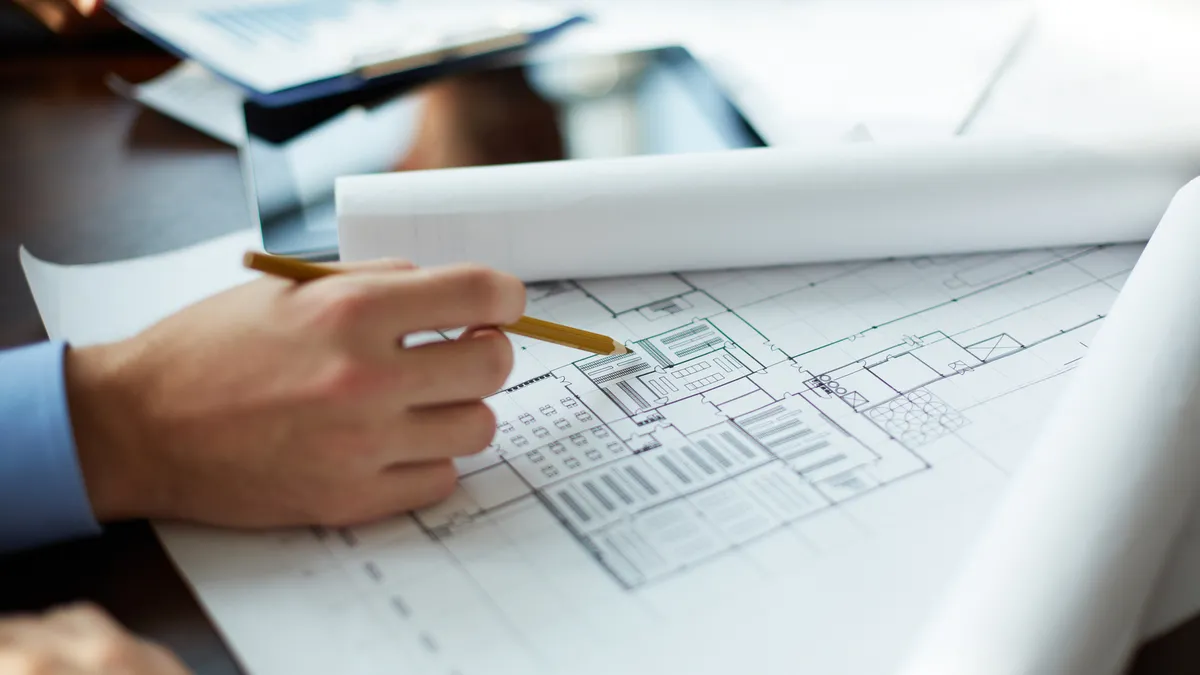UPDATE: May 20: Demand for U.S. design services last month saw its steepest decline on record, according to a new report today from The American Institute of Architects (AIA).
AIA’s Architecture Billings Index score of 29.5 for April reflects a decrease in design services provided by U.S. architecture firms (any number below 50 indicates a decrease in billings). During April, both the new project inquiries and design contracts scores also declined significantly, posting scores of 28.4 and 27.6 respectively.
“With the dramatic deceleration that we have seen in the economy since mid-March, it’s not surprising that businesses and households are waiting for signs of stability before proceeding with new facilities,” said AIA Chief Economist Kermit Baker in a statement emailed to Construction Dive. “Once business activity resumes, demand for design services should pick up fairly quickly. Unfortunately, the precipitous drop in demand for design services will have lasting consequences for some firms.”
Regional averages for April varied from 38.1 for Western states to a low of 23 for the Northeast. Billings for commercial and industrial projects declined the most, followed by mixed practice, multifamily residential and institutional.
Dive Brief:
- Demand for design services from architecture firms recorded its largest-ever monthly decrease in March, according to The American Institute of Architects (AIA). Billings at architecture firms plummeted last month as the Architecture Billings Index fell by 20.1 points to a score of 33.3, the largest single-month decline in the index's nearly 25-year history, far surpassing the declines of 9.4 points seen at the start of the 2001 recession and 8.3 points seen at the start of the Great Recession.
- Released yesterday, the index reported that billings declined across all regions of the country and all firm specializations. In addition, new project inquiries and new design contracts experienced a steep decline as well, posting scores of 23.8 and 27.1, respectively.
- The dramatic drop in demand for architecture services portends an equally dire future for the construction sector, according to Dodge Data & Analytics Chief Economist Richard Branch, who said he expects construction starts in the second quarter to post a drastic decline. "A pullback in new jobs and delays to ongoing projects will lead to a sharp retreat in activity across virtually every sector of the construction industry," he told Construction Dive.
Dive Insight:
Associated Builders and Contractors Chief Economist Anirban Basu also sees a steep decline in activity for U.S. commercial builders. He told Construction Dive he believes it will occur in three phases.
Phase one includes the current impact of social distancing directives and other CDC recommendations on construction activity, as well as shutdown orders in Boston, Pennsylvania and California.
Phase two will be the result of the downturn of the U.S. economy, which will bring the deepest recession since the Great Depression, he said.
"Construction activity tends to lag the broader economy by 12 to 18 months, so that weakness will eventually catch up with the construction sector," he said.
ABC's latest Construction Backlog Indicator released earlier this week suggests that backlog is already under pressure, falling 7.7% to 8.2 months in February. In addition, its most recent Construction Confidence Index, based on a survey of members conducted March 20-31, revealed that contractors' expectations for sales, profit margins and staffing levels fell below the threshold of 50 for the first time in the history of the series.
Related Stories
Construction Dive Industry Pulse: The latest construction data and statistics
The AIA data indicates that phase two could begin sooner than expected, with many projects being canceled in large numbers and many project owners likely invoking force majeure clauses in contracts in order to avoid the costs of cancellation that normally accompany such decisions, Basu said.
Phase three involves a longer-term malaise in construction activity as empty storefronts and office suites remain pervasive for years to come.
In an AIA survey of members released late last month that asked firms to project their losses through the end of the second quarter of 2020, 94% of responding firms indicated that they expect a decline in revenue during that time, with more than one-third anticipating losses of 25% or more. On average, architecture firms now expect revenue losses of 17% over the next three months.













